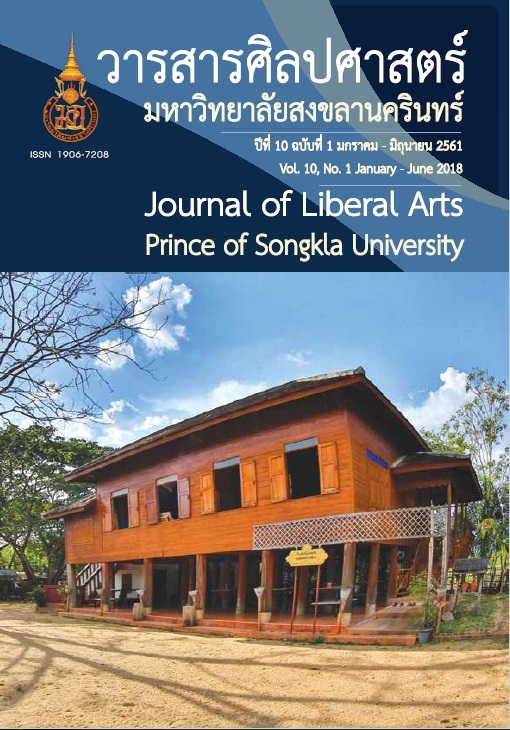Health status and dependency of Thai elderly in an urban area: Hat Yai Municipality
Keywords:
Elderly, health status, dependency, municipality, urbanAbstract
This survey research aimed to explore the health status and dependency of the elderly in Hat Yai municipal area. Multi-stage random sampling was used to recruit 400 elderly who were community dwellers in Hat Yai City. The data were collected using five sets of questionnaire: 1) personal profile, 2) physical health status, 3) functional ability (Barthel ADL index and Chula ADL index), 4) depression screening questions (2Q/9Q) and Abbreviated Mental Test (AMT), and 5) social and environmental health survey. All questionnaires were evaluated for their content validity by a panel of 3 experts and their reliability was examined using interrater evaluation (average percentage of agreement = 99.0%). The data were analyzed using frequency, percentage, mean, and standard deviation. The results revealed that over half of the elderly (59.1%) perceived that they had moderate health status (no/well controlled chronic illness). Most were obese (BMI > 22.9 = 67%) and had above-normal waist circumference (65.8%), had underlying diseases (75.3%) and experienced at least one symptom in the past month (72.0%), had no fall (90.6%) or accident (98.7%) in the past year, performed regular exercise (70.8%), and had no risky behaviors (95.8%), no depression (95%) and no other mental health problem (89.7%).
Considering their activities of daily living (ADL) index, 96.8% were socially-bound (ADL > 12). 2.2% were bed-bound (ADL 0-4), and only 1.0% were home-bound (ADL 5-11), whereas 30.8% were dependent on others to do outdoor activities. More than half (53%) had a balanced budget. Most had children as caregivers (83.0%), received continuous care from their family members (92.0%), and had appropriate living arrangement (81.5%), but 18.5% had no suitable toilet. Almost half (49.5%) participated in community activities.
References
Aroonsang, P. (2011b). Nursing of elderly’s problems. Khonkaen: Klangnanawittaya.
Assantachai, P. (2011). The basic principles of geriatrics. In Prasert, A. (Ed.). The common Health problems in elderly and prevention (p.1-13) (3rd ed.). Bangkok: Union Creation. [In Thai]
Bureau of Registration Administration Hat Yai Municipality. (2016). House statistics from household registration and population statistics detail of local information of Hat Yai Municipality in September 2016. [In Thai]
Boongird, C. (2009). Comprehensive geriatric assessment (CGA): How to change the system of primary care. The Thai Journal of Primary Care and Family Medicine, 32, 32-36. [In Thai]
Boonthamcharen, K. (2009). Dependency of the elderly. In Wichawut, Ch., and Thanaviriyakul, S. (Eds.). Long term care system and health care team for elderly: Thai setting. (p.1-12). Bangkok: Foundation of Thai Gerontology Research and Development institute. [In Thai]
Choorat, W., Sawangdee, Y., & Arunraksombat, S. (2012). Factors influencing the risk of having mental health problems of Thai elderly. The Thai Population Journal, 3(2), 87-96. [In Thai]
Institute of Geriatric Medicine Department of Medical Services. (2005). Interdisciplinary Elderly Medical Care. Bangkok: The Agricultural Co-operative Federation Of Thailand., LTD. [In Thai]
Jitapunkul, S. (1998). Principles of geriatric medicine. Bangkok: CU Print. [In Thai]
Kongthong, M. (2011). Quality of life of the elderly: A case study in the railway community in Hat Yai Municipality. (Unpublished master’s minor thesis), Prince of Songkla University, Songkhla Province. [In Thai]
National Statistical Office. (2014). Preliminary reports: Survey of elderly in Thailand 2014. Bangkok: National Statistical Office. [In Thai]
Office of the National Economics and Social Development Board. (2013). Population Projections for Thailand 2010-2040. Bangkok: Deuantoola. [In Thai]
Pothiban, L., Wathisunthon, M., & Pan-uthai, S. (2010). Development of the older people dependency screening tool for village health volunteers. Bangkok: Foundation of Thai Gerontology Research and Development institute. [In Thai]
Prachuabmoh, V. (2012). Annual report on the situation of the elderly in Thailand 2011 (p.1-96). Bangkok: Phongphanich Chraenphol Co., Ltd. [In Thai]
Prasartkul, P. (2014). Situation of the Thai elderly in 2013. In Rittirong, J., Chuanwan, S., Kanchanachitra, M., Jaratsit, S., Katewongsa, P., Thianlai, K., Mathuam, Ch., & Aruntippaitune, S. (Eds.), Situation of the Thai Elderly in 2013 (p.1-119). Bangkok: Ammarin Printing and Publishing. [In Thai]
Rakchanyaban, U., Vapattanawong, P., Prasartku, P., Porapakkham, Y., & Aekplakorn, W. (2009). Disability and risk factors of disability among the Thai older population. Ramathibodi Nursing Journal, 15, 111-125. [In Thai]
Rubenstein, L. V., Calkins, D. R., Greenfield, S., Jette, A. M., Meenan, R. F., Nevins, M. A.Williams, M. E. (1989). Health status assessment for elderly patient’s report of the society of general international medicine task force on health assessment. Journal of the American Geriatrics Society, 37, 562-568.
Yamane (1973, as cited in Srisatidnarakul, B., 2010). The methodology in nursing research. (5thed.). Bangkok: U&I Inter Media. [In Thai]
Srithamrongsawat, S., Boontham Charen, K. (2010). Synthesis of longterm care system for the elderly in Thailand. Bangkok: T.Q.P. [In Thai]
Suwannaruj, D. (2012.). Indicating factors of disability differences: Female and male Thai Elderly. Journal of Social Development, 14, 1-18. [In Thai]
Thongdee, J., Rongmuang, D., & Nakchattri, C., (2013). Health status and quality of life among the elderly in the southern border provinces of Thailand. Nursing Journal of the Ministry of Public Health, 22, 88-99. [In Thai]
United Nation. (2002). World population ageing: 1950-2050. Department of Economic and Social Affairs, Population Division. Retrieved from http://www.un.org/esa/population/publications/worldageing19502050/.
Wiruchnipawan, W. (2011). Analyzing the characteristics of Thais as obstacles to the development of the country. Retrieved fromhttp://www.pattanakit.net/ index.
Downloads
Published
How to Cite
Issue
Section
License
The authors retain the copyright to their article but the Journal of Liberal Arts, Prince of Songkla University reserves the exclusive rights to first publication.






